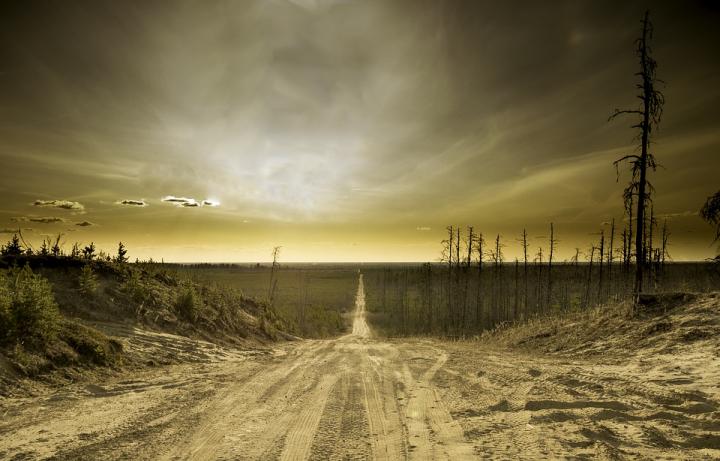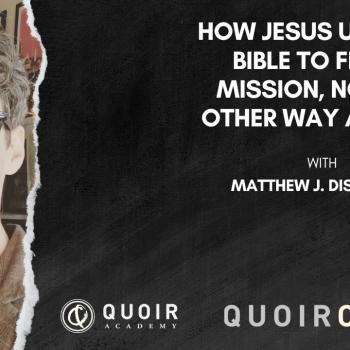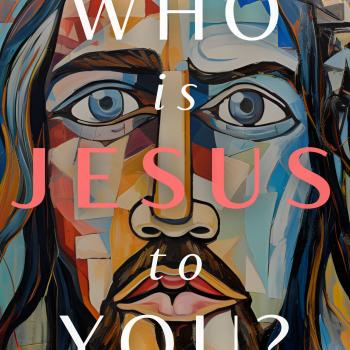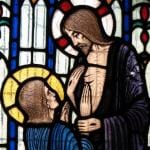
Earlier this month, President Donald Trump made the announcement that the United States was going to recognize Jerusalem as Israel’s capital. Among other things this has done, the news has excited many on the Religious Right—those who tend to hold to a Rapture-based, dispensationalist, “Left Behind” theology—to such an extent that they are anticipating the end of the world to come at any moment now (as if that’s anything new). With their Scofield Reference Bible firmly in hand, they’ll likely tell you that all of the pieces are finally in place for the Rapture of the Church and subsequent slaying of the wicked at the hands of Jesus himself.
The problem with this view, among many, is that it really has nothing to do with either Judaism or early Christianity. Indeed, it has nothing to do with the Bible. Sure, the Bible speaks of “apocalypse,” but what that should come to mean is not what the dispensationalists would have us believe.
Here’s why.
In Greek, the word “apocalypse” literally means “an unveiling.” Most appropriately, with regards to Christian theology, it refers to an unveiling of the revelation of Christ Jesus, the Logos (Word) of God. The apocalypse of God in the first century was, most specifically, that his nature is “love” and “light” (1 John 1:5, 4:8) and that his Gospel is peace (Eph 6:5). How do we know? As Paul puts it, “in him [Christ] the whole fullness of deity dwells bodily (Col 2:9).” Or, to say it another way, that God’s nature was, is, and will always be like that of Christ Jesus (Heb 13:8) and that thinking about theology begins, not in glory, but at the foot of his cross. To that end, any notion of a split apocalypse—where on the one hand the nonviolent Logos of God was revealed in Jesus Christ (John 1:1–5) and on the other that he, sometime in the future, will be revealed as a bad-ass Pride fighter (as Calvinist blogger Mark Driscoll once infamously stated)—is theologically absurd and should come to have no bearing on the peace-laden Gospel (Eph 6:5) of the One whom we build our foundation on (1 Cor 3:11).
Nevertheless, when we do assume a dualistic eschatology such as the one Driscoll assumes—one where the Universe is split, some to the blissful afterlife in the clouds and others, some of which are apparently actually whacked by Jesus himself, to the perpetual barbecue down below—we actually have a tendency to miss the overwhelming New Testament teaching that we “believers” are not only to anticipate, but help bring about, insofar as we are able, God’s wholly restored kingdom “on earth as it is in heaven” (Matt 6:10). In other words, our Christian focus isn’t to be so much on where our eternal destiny lay, although that certainly bears consideration, but on transforming the present reality in light of the post-resurrection eschatological truth that all death and all tears of sorrow will be done away with forever (Rev 21:4). N.T. Wright notices the very same focus among the early Christians:
For the early Christians, the resurrection of Jesus launched God’s new creation upon the world, beginning to fulfill the prayer Jesus taught his followers, that God’s kingdom would come “on earth as it is in heaven” (Matt 6:10), and anticipating the “new heavens and a new earth” (Isa 65:17; 66:22; 2 Pet 3:13; Rev 21:1) promised by Isaiah and again in the New Testament . . . The early Christians were not very interested, in the way our world has been interested, in what happens to people immediately after they die. They were extremely interested in a topic many Western Christians in the last few hundred years have forgotten about altogether, namely the final new creation, new heavens and new earth joined together, and the resurrection of the body that will create new human beings to live in that new world. (Wright, Surprised by Scripture, 84)
This is a view that, while in some ways uniquely Christian, draws many parallels with its Jewish parents. In the next section, we will explore how this prophetic trajectory, beginning with the Hebrew Scriptures and then culminating in the Christian apocalyptic book of Revelation, consistently portrays a hopeful vision of the end, not merely one that ends in death and destruction.
A Prophetic Vision of the End
Isaiah
Included in many of Isaiah’s writings are visions of a glorious future; of a “New Jerusalem” shrouded in peace, one where even “the wolf and lamb shall feed together, [and] the lion shall eat straw like the ox” (Isa 11:5–7; 65:25). This is not simply to say that all of God’s creatures will one day adopt a vegan lifestyle—although I suppose it’s possible—but rather, that in a future time, or age, “all the nations,” having beaten “their swords into plowshares, and their spears into pruning hooks,” will live in peace in the City of God (Isa 2:2–4). In spite of all the conflict and trouble “the nations” cause Israel—and vice-versa I imagine—one day there will be perfect, divine tranquility. In spite of the “wicked” nations being rebellious and suffering defeat (Isa 34:1–2; 60:12, 20), they will one day bask in the light (Isa 60:3) of God’s “new creation” (Isa 65:17; 66:22), bringing their “wealth” into the heavenly places (Isa 60:5, 11), honoring God’s people all the while (Isa 60:14, 16).
Jeremiah
Jeremiah envisions something similar. Like Isaiah, he too foresees a time where former enemy nations are restored by God. In chapter 48, the prophet tells of the destruction of Moab. These were, as Jeremiah says, a prideful people (Jer 48:29) who had a knack for boasting in false deeds (Jer 48:30); so much so that it leads to their ruin. Her people cry out over their fate (Jer 48:4) as they are “laid to waste” (Jer 48:20). Yet, after all this fiery judgement, God promises to “restore the fortunes of Moab in the latter days” (Jer 48:47). And again, in chapter 49, Jeremiah tells of a similar fate for Elam. After they have disaster and the sword of the Lord brought down upon them (Jer 49:37), killing their kings and officials (Jer 49:38), their fortunes are restored, again “in the latter days” (Jer 49:39).
Ezekiel
In Ezekiel, the infamous Sodomites experience a similar fate. Now, we all know the first part of Sodom’s story, the part where she, alongside her sister city Gomorrah, are annihilated by fire and sulfur from heaven (Gen 19:24) for their depravity (Gen 19:1–11; Ezek 16:49–50). Ezekiel describes their wickedness as follows: “She and her daughters had pride, excess of food, and prosperous ease, but did not aid the poor and needy. They were haughty, and did abominable things before me.” Some of those abominable things included, but were not limited to, a potential gang rape of a couple of angels (Gen 19:4–5). And so, they are nuked from above, and no one who stays in the city makes it out alive. In fact, even Lot’s wife gets smote for daring to look back on the ruin (Gen 19:26). Yet, what is then quite striking is that in spite of this utter destruction, the prophet still anticipates a hopeful fate: “I will restore their fortunes, the fortunes of Sodom and her daughters (Ezek 16:53).”
Zechariah
The prophet Zechariah also anticipates a time of perpetual peace, one ushered in by the apocalypse of a future king—and not peace through force and enemy-slaying, but peace that overcomes such things:
Rejoice greatly, O daughter Zion!
Shout aloud, O daughter Jerusalem!
Lo, your king comes to you;
Triumphant and victorious is he,
Humble and riding on a donkey,
On a colt, the foal of a donkey.
He will cut off the chariot from Ephraim
And the war-horse from Jerusalem;
And the battle bow shall be cut off,
And he shall command peace to the nations;
His dominion shall be from sea to sea,
And from the River to the ends of the earth. ~Zech 9:9–10
In a completely subversive way, the king who comes to “command peace to the nations” rides in on a humble donkey instead of a proud war-horse. In fact, his triumph and victory is when he cuts off the horses and chariots of war, and when he breaks the bows of battle, not when he wields them fiercer than any other. In doing so, he is given dominion over all the earth, from sea to shining sea. That is to say, he is given dominion over all humanity; indeed, all the nations (Isa 52:15).
The Book of Revelation
At first glance, one may assume the book of Revelation reads quite dissimilarly than that of the prophets. Indeed, we can all probably see why most of the violent images of Jesus coming back to send the great majority of humanity to hell arise from this book. The language here, at times, is brutal, the imagery stark. And not only that, but all of the horror that is said to be coming is attributed to “the Lamb,” or in other words, Christ Jesus himself (Rev 6:16). A scary picture of God indeed!
However, as serious as we should take the warnings contained in this piece of literature, we shouldn’t be too fixated on drawing our theological conclusions from it.
Let me explain.
As we mentioned earlier, the apocalypse of God is most wholly seen in the figure of the first-century Jesus of Nazareth, the figure whom God worked through to “reconcile all things” by freely offering forgiveness from the cross (Col 1:15–20; Luke 23:34), and by speaking the word of peace and mercy after it (John 20:19–23, 26; Heb 12:24). So, it is not as if in some future age this will fail to be. Of course not! For, as the writer to the Hebrews put it: “Jesus Christ is the same yesterday and today and forever” (Heb 13:8). In other words, our God is an eternal God (Gen 21:33, Ps 90:1–4).
Having this in the forefront of our minds—as our lens so to speak—is what it means to be under a “theology of the cross.” We could also call it Christocentric (centered on Christ) and if we emphasize the non-retributive Christ as the eschaton, or ultimate end/goal, we could say it is Christotelic. John 12:31–33 captures this idea beautifully (all emphasis mine):
“Now is the judgment of this world; now the ruler of this world will be driven out. And I, when I am lifted up from the earth, will draw all people to myself.” He said this to indicate the kind of death he was to die.
As we’ve mentioned, the kind of death being spoke of was an earth-shattering one. It was the revelation of a God JUST. LIKE. JESUS. That means no matter what, Christ’s life, death, resurrection, and ascension determine how we think about anything, including the book of Revelation. Not the other way around!
That being said, in John’s Revelation this “theology of the cross” theme is in fact introduced, as odd as that may initially sound. To begin, in Revelation 5, John envisions a scroll that, at the onset, is unable to be opened by anyone “in heaven or on earth or under the earth” (Rev 5:3). Because it is obviously an important scroll, and something that certainly must be opened, the fact that as of yet it hasn’t been causes John great grief, to weep bitterly even (Rev 5:4). Quickly though, one of the elders comforts him: “Do not weep. See, the Lion of the tribe of Judah, the Root of David, has conquered, so that he can open the scroll and its seven seals” (Rev 5:5). Then, obviously expecting to see a lion, John turns and instead, sees a lamb as if slain (Rev 5:6). What a revelation this is! Sure, like lions are wont to do, Christ has conquered, but he has done so by behaving as a slain lamb. Similar to the Suffering Servant from Isaiah, then, all power and authority is subverted and given to one whom nobody expects (Isa 52:15), and it is he who is worthy to open the scroll.
When we come to all the “wrath of the Lamb” talk in the following chapter, we must bear this in mind. Wrath, here, like in Paul’s letter to the Romans, is a very specific and nuanced wrath (Rom 2:5). It is the giving over to the natural consequences of a humanity that refuses to care for the “least of these,” for one example (Matt 25:31–46). Brad Jersak puts it like this:
“The wrath of the Lamb” is a metaphor for God’s consent (‘giving over’) to the intrinsic self-destructive consequences (natural and supernatural) of humankind’s rebellion. It is wrath because we experience these consequences in ultraviolent ways—as if God were angry—but the Lamb is only indirectly complicit because, he operates by Lamb-like consent rather than coercive intervention. (Jersak, “I Saw a Lamb,” 318)
This “giving over” is seen, most strikingly, all throughout Revelation 6. And, as Jersak notes, the calamity that takes place after the Lamb opens the seals is purely anthropological. It is humanity and her persistence toward violence, for instance, that empowers the four riders: the white rider conquers with a bow (Rev 6:2—contra John 12:15; Zech 9:8–9), the red rider takes peace with a sword (Rev 6:4—contra Matt 26:51–52), the black rider’s economic scales are imbalanced (Rev 6:6—contra Matt 25:31–46; Luke 4:18–19; 6:20, 24; 16:19–31), and the pale green rider, whose name was Death and Hades, kills with sword, famine, pestilence, and beasts of the earth (Rev 6:8—contra Isa 11:6; Matt 26:51–52; Mark 1:40–45; Luke 17:11–19; John 6:1–15). Then, after this doom befalls the world, the martyrs, like Abel long, long ago, cry out for vengeance (Gen 4:10; Rev 6:10—contra Heb 12:24).
Yet, none will come, for the blood of Jesus speaks a better word than Abel (Heb 12:24). Any vengeance that is coming, then, is only that which we have stored up for ourselves by our hard and impenitent hearts, as Paul once put it (Rom 2:5). Toward the end of Revelation 6, it is described, in classic Jewish fashion, in the most apocalyptic of ways: the sun goes dark, the moon becomes like blood, the stars fall to the earth, the sky vanishes like a rolled-up scroll, and mountains and islands are removed from their place (Rev 6:12–14; Isa 13; 34). Kings shutter and declare it the end of the world, for the “great day of their wrath” is upon them (Rev 6:17).
But is this truly describing the end of world? Yes and no, says Jersak:
The apocalyptic language here is borrowed directly from Isaiah 13, 34 and Matthew 24. Isaiah 13 ascribes the cosmic meltdown to the Day of the Lord when God in his anger destroys the Babylonian empire. In similar language, Isaiah 34 refers to the retributive vengeance that completely wipes out the nation of Edom. And in Matthew 24, Jesus cites these texts to announce the obliteration of Jerusalem within one generation. In every case, the cosmic imagery refers to temporal earthly events already fulfilled in history through the destruction of a city, kingdom or empire by military sieges from foreign armies. (Ibid., 320)
Some would be inclined to push back and say that the events described in Revelation, contrary to that of Isaiah and Matthew, are not at all about events already fulfilled in history but rather, events that are to come. And perhaps to some extent they would be correct. Perhaps not all of the events of Revelation have been fulfilled. That is fair. Then again, perhaps others are fulfilled over and over ad nauseam. Perhaps it is more than either/or, but rather, both/and. Perhaps the two opposing cosmic entities—New Jerusalem and Babylon—are such that the events that play out in the book are really a way to talk about the two paths humanity can choose to walk down. Perhaps this choice was directly applicable in the first century, in the centuries that followed, and even today and into the future.
Perhaps.
Nevertheless, no matter how you slice it, two things we can trust. First, any “end of the world” event will always be brought about by wrath and vengeance that we store up for ourselves. The Lamb simply permits it, as he did in the first century, as he does throughout history, and as he will do until this age passes into the next. But, don’t think that, in the end, the Lamb won’t find a way to be victorious. May we never believe that! There always remains hope because no matter how brutal the cosmic battles may be, no matter how dire things become for any who oppose the Lamb (Rev 20:15), there is a promise that waits to be fulfilled, and the whole creation groans for this future time (Rom 8:18–25).
The Gates of New Jerusalem
Almost shockingly—given the stark imagery throughout the book—the conclusion to Revelation foretells of a promising and hopeful future that is not unlike the one Isaiah painted long before. In Isaiah 2, the prophet foresees a coming time when all the nations shall stream to the Lord’s house (Isa 2:2–3). In Revelation 22, the invitation is sent out: “The Spirit and the bride say, ‘Come.’ And let everyone who hears say, ‘Come.’ And let everyone who is thirsty come. Let anyone who wishes take the water of life as a gift.” (Rev 22:17) To whom is this invitation sent? Those outside the city, of course. But who is outside the city? Both Revelation 21:8 and 22:15 tell us:
- Rev 21:8: “As for the cowardly, the faithless, the polluted, the murderers, the fornicators, the sorcerers, the idolaters, and all liars, their place will be in the lake that burns with fire and sulfur.”
- Rev 22:15: “Outside are the dogs and sorcerers and fornicators and murderers and idolaters, and everyone who loves and practices falsehood.”
To put it simply, to be in the lake of fire is to be outside the gates of New Jerusalem. There are no two ways about it. It is a fate suffered by not only the wicked listed above, but also the kings of the earth and “the nations” who wage war against the Lamb (Rev 6:15; 17:14 19:18–19; 20:8). The bad guys, if you will.
So, the question is: Will they come? Will they take up the call? “Yes, one day” says John: “The nations will walk by its light, and the kings of the earth will bring their glory into it” (Rev 21:24). That is the hope anyway. And it’s the same hope Isaiah had: “Nations shall come to your light, and kings to the brightness of your dawn” (Isa 60:3).
This isn’t some cheap invitation, however. Nay! Those who enter the perpetually open gates of New Jerusalem (Isa 60:11; Rev 21:25) in order to drink from the life-giving waters (Isa 55:2; Rev 22:1–2) and partake of the tree that is for the “healing of the nations” (Rev 22:3) will have to have their “robes washed in the blood of the Lamb” (Rev 22:14). That is to say, those outside the city, once they hear the Spirit and the bride’s call to “come,” will have to draw near to Christ in order to experience the healing that is perpetually and mercifully set before them.
Concluding Thoughts
Theologically, what can we conclude from this? Given the fact that this book is based off a vision, probably not much. But, what cannot be emphasized enough is that the Lord Jesus Christ is the same yesterday, today, and forever (Heb 13:8). In other words, Christ’s nature remains consistent, no matter the epoch, no matter the circumstance, no matter the situation. To that end, if Christ is coming back—and I continue to hold fast that Christ indeed is—it won’t be to defeat his enemies with violence and war, but by destroying that which causes them to be an enemy in the first place, so that they can one day heed the call to “come” and be healed. Until that day, we can have hope. We can hope for a future time when everyone enters through the open gates to partake of the feast. We can share in Isaiah’s hope, and Jeremiah’s, and John the Revelator’s. Dare I say, we can share in Jesus’ hope, the savior of all people, especially of those who believe (1 Tim 4:10). And we can, as the bride of Christ, with tears in our eyes, leave behind our “Left Behind” theology and continue to send out the invitation to “come” be reconciled to God!
*Note, much of this content has been adapted from my yet to be published book “Heretic! An LGBTQ-Affirming, Divine-Violence Denying, Christian Universalist’s Responses to Some of Evangelical Christianity’s Most Pressing Concerns

















